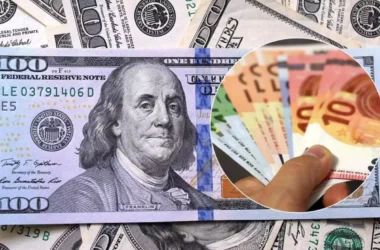In early February, Alphabet, the parent company of Google, announced its plans to conduct a stock split. This will take place already in July this year. We are looking into whether it is possible to make money from this, what the company and its shareholders will get from it, the Ministry of Finance reports.
Alphabet decided to split (or, as it is also called, split) in a ratio of 20:1. This means that an investor who theoretically currently owns 1 share of Alphabet will own 20 shares of the company after the split.
On July 15, the brokerage accounts of investors who were shareholders of the company as of July 1 will receive an additional 19 shares for each paper held. On the next trading day, July 18, the share price will decrease proportionally – by a factor of 20. That is, shares of Google’s parent company will trade in the region of $142 (based on the current share price of approximately $2,832).
For example, investment guru Warren Buffett is not a fan of stock splits. In a 1983 letter to his shareholders, Berkshire Hathaway’s CEO wrote: “A stock split would increase the cost of transferring shares, reduce the quality of our shareholder pool, and drive a market price less consistently linked to the intrinsic value of the business. We don’t see any offsetting benefits.”
That’s why Berkshire’s Class A shares have never split. They debuted at a price of $19 in 1965 and now trade for about $483,900.
But not all successful companies take this position. According to Howard Silverblatt, senior index analyst at S&P Dow Jones Indices, S&P 500 companies have had 26 stock splits between 2017 and 2021 alone.
For example, in August 2020, Apple and Tesla split their shares 4:1 and 5:1, respectively. In July of last year, a 4:1 stock split was conducted by NVIDIA.
Often, investors who receive news of a stock split are concerned about how it will affect their portfolio. Technically, after the split, all investors will still own the same stake in the company as before. Will not change the division and total capitalization of the company.
Why do companies take this step, and why is Alphabet now conducting a split?
The first reason: expansion of the circle of investors
“The main purpose of the split is to enable retail investors to buy shares at a better price. For example, if the Apple company had not split (in total, the iPhone manufacturer’s papers were split 5 times – ed.), then its shares would be worth more than $30,000 now,” explains Mykhailo Patsan, asset manager, investor, Chief Investment Officer at Multi Invest.
In other words, thanks to the splitting of their shares, companies expand the circle of potential investors, give the opportunity to buy their papers to those who are not ready to pay several thousand dollars for a share. By the way, even Berkshire Hathaway has, so to speak, a budget investment option for a mass investor – Class B shares for $322 (current today’s price) per piece.
As a result of the last split, the price of Apple shares fell from $500 to $125, after crushing the Tesla paper, the price fell from $2,400 to $480. Instead, retail purchases of these papers skyrocketed.
According to the calculations of Vanda Research analysts, if before the 2020 split, the weekly purchases of Apple shares by retail investors did not reach $150 million, then after the split they jumped to almost $1 billion.
Tesla’s weekly retail purchases after crushing increased from $30-40 million to $700 million.
Alphabet’s upcoming stock split has its own quirks.
“The 20:1 split ratio used by Alphabet is not quite standard. More traditional values for this procedure range from 2:1 to 10:1. Most likely, in this way the company plans to attract the interest of small investors to its shares as much as possible. Since the price with such a division will be very attractive both for speculation and for long-term investment,” says Oleh Alekseev, Alpari analyst.
“The higher the fragmentation ratio, the more the company targets investors with medium/small capital,” says Roman Kalinovsky, an analyst at Freedom Finance.
Mykhailo Patsan clarified that the company splits shares in such a proportion that the new price is at the level of the average check of a retail investor, and also does not stand out by price against the background of other shares.
“Observations show that companies due to splits and mergers tend to maintain share prices in the $50-$300 range, mostly choosing a price around $100,” said Volodymyr Pozniy, head of EXANTE Ukraine.
Alphabet’s shares are now among the most expensive in the United States, and after the split, their price will not exceed $150, which will put them in the same value range as the papers of other Silicon Valley giants that attract the attention of retail investors.
Another reason for Alphabet to do the split right now is the impending tapering of the Fed’s large-scale financial infusions. Much of this money used to end up in the stock market. After strengthening the monetary policy by the regulator, the market will no longer be bathed in liquidity, as it is now. Accordingly, companies are looking for opportunities to support interest in their securities.
“The reason for the division is that it makes our stock more affordable, said Ruth Porath, Alphabet’s chief financial officer, during a conference call with TV hosts. We thought it made sense.”
Splitting shares not only makes them attractive to small investors by lowering the price. For example, after the split, the value of shares of the same Alphabet will return to 2005 levels. This procedure also makes it possible to increase the liquidity of the shares. In other words, if the investor wants to exit the investment, the shares can easily be exchanged for cash.
Finally, investors like stock splits because it creates a positive image for the company. The market perceives companies participating in the division as a growing organization, at least according to numerous studies on this topic.
Reason two: Targeting the Dow Jones
Another motivation for Alphabet to split its shares could be to enter the Dow Jones Industrial Average. The fact is that the archaic Dow Jones system is not focused on the market capitalization of participating companies, but on the price of their shares. Alphabet’s current share price is too high for Google’s parent company to be added to the index without “crushing” the rest of the participants.
“A 20:1 stock split could attract more retail investors to the stock and could help pave the way for inclusion in the Dow,” UBS analysts said in a research note.
According to S&P Dow Jones Indices, changes to the Dow are made “as needed”, the composition of the index can be revised at any time “in response to corporate actions and market developments”.
“Although the selection of stocks is not governed by quantitative rules, stocks are usually added only if the company has an excellent reputation, shows steady growth and is of interest to a large number of investors,” said the methodology document for the Dow Jones indices. It also suggests that share price is a significant factor when considering a company applying for inclusion in the Dow.
“Fresh money from retail investors and speculation around inclusion in DJIA can help Alphabet feel better than its competitors,” Volodymyr Pozniy explains the company’s main goal.
How to make money on the Alphabet split
Splitting shares indirectly affects the capitalization of the enterprise. For example, after analyzing the splits of companies with high capitalization from 2012 to 2018, researchers from Nasdaq Economic Research found that the announcement of a stock split alone gave an additional increase to the value of the securities by an average of 2.5%. Within a year after the split, this figure increases to 5%.
The BKS Investment World study, which analyzes 101 splits from 2000 to 2019, shows that in the two weeks before the split date and in the three months after it, shares of the companies that carried out the split outperformed the broad market index S&P 500. However, the authors of the study specify , that mergers are usually conducted by large, growing companies that are already ahead of the market.
“Usually, in the first days after the split, the price of the company’s shares increases, as new investors have joined who could not buy the shares before. Therefore, it is possible to conduct a speculative transaction and buy shares after the announcement of the split and sell in the first days after the procedure itself. Here it is important to take into account that the split does not affect the economic indicators of the business, so only the shares of really promising companies will grow,” Mykhailo Patsan comments on the potential opportunities for earning.
However, the fact of the split itself should not affect the long-term strategies of the investor, experts assure. Serhii Rodler, an analyst at TeleTrade, says that the split may contribute to the growth of interest in the paper from small players in the long term.
“But a lot will depend on the state of the market. If the general trend is negative, then it is unlikely that any serious growth should be expected. In other words, reacting to information about the split and building your investment strategy from it is not worth it.
It is necessary to study the fundamental indicators and look for good points to enter the chart. The other day, the value of Alphabet’s shares soared by almost 10%, but the point here is a good quarterly report. In addition, after such movements, and also by a gap, you can see a reverse movement to $2,500−2,700,” Serhii Rodler explains.
Freedom Finance analyst Roman Kalinovskyi maintains a similar position.
“If the investor bought the company’s shares before the announcement of the split, then the moment after the announcement will be a good opportunity to exit the position. Because usually after a public declaration of such an intention, the share price increases. But don’t forget about your personal investment strategy. As a short-term speculation, it may be a good move, but in the long-term, the stock split does not significantly affect the company’s market value,” he says.








